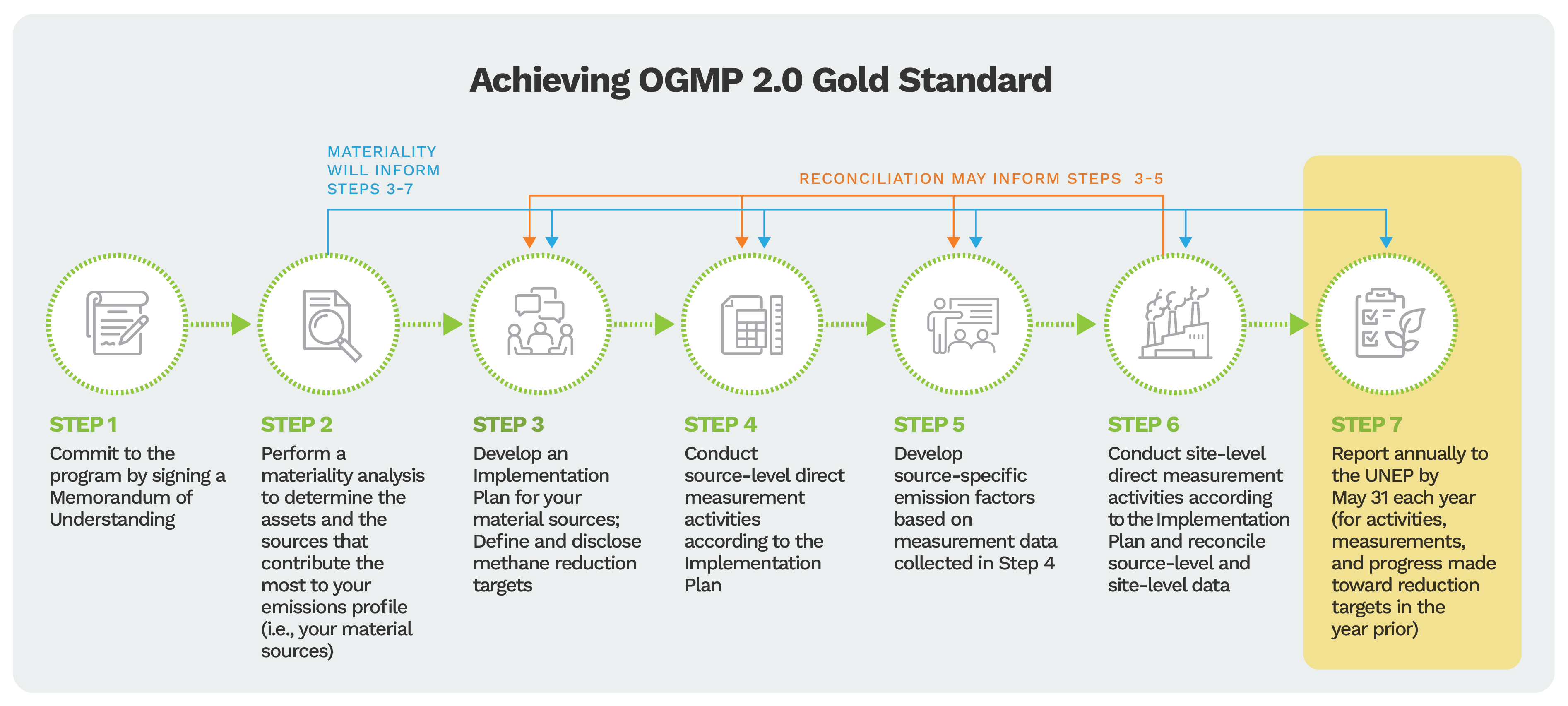
Lessons Learned from the 2024 OGMP Reporting Season:
Key Gold Standard Recommendations for Reporting and Emissions Measurement
November 7, 2024
In May 2024, many member companies and Montrose clients submitted their Year 2 Annual Report for the Oil and Gas Methane Partnership 2.0 (OGMP.) This submission represents a significant milestone in their implementation plans with clear evidence of achieving Level 4 and 5 reporting on their path to attaining Gold Standard, requiring strategic planning and a dedicated effort.
After a company submits its annual report, the OGMP team provides preliminary feedback before a final award is determined, along with additional guidance for the following year’s report. A reoccurring theme in this year’s feedback was the need for additional detail to enhance transparency, aligning with OGMP’s published guidance on the high-quality measurement data essential for emissions inventory development.
Building on three successful years of supporting our clients with OGMP 2.0 – through execution of the OGMP framework and incorporating feedback from the United Nations Environment Program (UNEP) OGMP team – we highlight several key lessons learned by us and our clients in this edition of the OGMP 2.0 blog series to help companies achieve Gold Standard emissions measurement and reporting.
Year 2 is a Big Year for OGMP Level 4 Inventories
In year 2, member companies are required to show significant progress in advancing through the phasing of the OGMP implementation plan. This includes integrating measurement programs into operations, gathering data, conducting analysis, and updating emissions calculations and requires a long-term plan with several shorter phases. The implementation plan should outline how a company will reach level 4 over time, without assuming a sudden leap to Levels 4 and 5.
By Year 2, companies are expected to achieve Level 4 reporting for specific sources or entire assets. The implementation plan and report must include specific Level 4 documentation. While the guidance for this documentation is vague, feedback from the OGMP team highlights several key concepts for the expected level of detail. Documentation should provide detail on elements such as parameter measurement, sampling programs, and uncertainty estimates. Below, we outline strategies for success in these areas.
Parameter Measurement
Companies that pursued measurement-based emissions estimates for sources should provide details about the measurement programs and how the data was used to calculate emissions. The sampling methods and calculations should clearly indicate what technology was used to collect data on each required parameter. Specific activity data such as the count of leaks is a primary piece of activity data regularly collected, but Level 4 documentation requires data on other pertinent parameters.
For example, while measuring the methane content of exhaust from a combustion device may be an obvious parameter, fuel consumption is an equally important variable influencing methane emission rates. How fuel flow is measured, or estimated, requires detailed inclusion for complete Level 4 documentation. Determining inputs of methane emission estimation should be well documented for all sources, along with the uncertainty of the chosen methods.

Sampling Programs
Transparent and honest reporting requires including information about the completeness of sampling populations compared to the entire inventory. Companies will need to take a close look at their inventory and determine whether the samples collected are representative of the characteristics of the full population. Where data shows a gap in the sample population, the phasing plan should identify steps to close the gap in the time remaining to achieve full Level 4 reporting (i.e. OGMP Year 3).
Unexpected data gaps may arise at any point along the path to Level 5. For example, a company may have estimated that they could measure a representative sample of leaks by the end of Year 2. However, if the company used population count emission factors for Level 3 leak quantification, the actual count of leaks may be much higher than previously estimated. Suddenly, the company is faced with the urgent need to conduct 2 or 3 times more measurements than originally planned.
Another scenario to consider is the high variation of emissions measurement data for a single source. Differences in emissions measurements may be attributable to specific qualities of the source. Companies should evaluate what qualities distinguish a higher-emitting piece of equipment from a lower-emitting one, such as equipment design, operational use, etc. Then, the company can consider developing distinct measurement-based emission factors to reflect these qualities. Whether these qualities are indicated within the existing equipment inventory may limit how measurement emission factors are applied or require significant efforts to update inventory data.
When examining emissions from incomplete combustion, one expectation is that lean burn engines will have higher methane emission rates than similarly powered rich burn engines. Results of measurements may support this expectation, yielding two sets of emissions factors, one for lean burn engines and one for rich. Representative application of the measurements to develop asset-wide Level 4 emissions estimates requires an inventory that differentiates the engine type. If a data gap is found for engine type, it may become critical to expend a significant effort to review records and update the inventory.
Alternatively, there may be no discernable difference between one high-emitting component and another that has a lower measured emission rate. The distribution of emission rates should be incorporated into the asset-level emissions estimates for that source using a sound statistical approach. Often the cause of one leaking connector is unrelated to another leaking connector at a different site. A high variation in emission rates is predicted and applying measurement-based emission rates across an asset will require different statistical approaches dependent on operational and inventory factors.
Uncertainty Estimation
Developing Level 4 methane emission estimates introduces a new variable, uncertainty. When using standard count-based emission factors, it is impossible to define a realistic level of uncertainty. Measurement-informed inventories exist with a level of uncertainty bound by the capabilities of the measurement technology as well as the variations of the inventory, operations, and environmental conditions. No two well pads have the same configuration or same operating parameters. Increasing the number of measurements and capturing the range of equipment and operations reduces uncertainty.
UNEP requires that OGMP member companies include an uncertainty estimate for each source, along with the emissions estimate, when reporting at Level 5. OGMP guidance advises that companies may propose their own statistical approach for their operations based on the observed emission distribution and the best information available. A company should be thoughtful about what information is currently available and what information is needed for credible documentation and estimation.
Not Sure how to strengthen programs or kick off 2025 planning?
Member companies should prioritize addressing emission sources that are most material to their operations. Companies may consider requesting early feedback on specific sections of your Implementation Plan before the reporting period begins.
As you strengthen your Level 4 programs to meet Gold Standard pathway requirements, you may find reconciliation to be a significant hurdle. Questions about documentation, measurement strategies, and addressing data gaps are common at this stage. For further insights and strategies, be sure to check back for the next installment of the OGMP blog series, where we’ll explore the complexities of reconciliation.
If you need additional support, don’t hesitate to consult with an expert to guide you through these challenges.
Let’s Get You to OGMP 2.0 Gold Standard
Our Sustainability and Climate Advisory team is eager to support operators and member companies in their journey to OGMP 2.0 Gold Standard.
Whether your company is considering joining OGMP 2.0 or will be submitting a Year 1, 2, 3, 4, or 5 report in 2025, Montrose has technical consulting and field measurement resources to provide support and help to get you to the Gold! Please reach out for a free consultation.
We provide the following technical OGMP 2.0 program services:
- Implementation plan development and execution
- Sampling plan development and execution
- Source measurement technology evaluation
- Measurement campaign deployment
- Measurement-based emission factor development
- Level 4 emissions reporting
- Reconciliation





